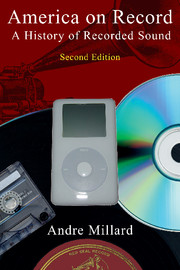Book contents
- Frontmatter
- Dedication
- Contents
- Preface to the second edition
- Preface to the first edition
- Introduction
- Part One The acoustic era
- Part Two The electrical era
- 6 The machines
- 7 Competing technologies
- 8 Empires of sound
- 9 Swing and the mass audience
- 10 High fidelity at last
- 11 Rock'n'roll and the revolution in music
- 12 The record
- 13 The studio
- 14 Perfecting studio recording
- 15 The cassette culture
- Part Three The digital era
- Abbreviations used in the notes
- Notes
- Select discography
- Select bibliography
- Subject index
- Recordings index
- Motion picture index
9 - Swing and the mass audience
from Part Two - The electrical era
Published online by Cambridge University Press: 05 February 2015
- Frontmatter
- Dedication
- Contents
- Preface to the second edition
- Preface to the first edition
- Introduction
- Part One The acoustic era
- Part Two The electrical era
- 6 The machines
- 7 Competing technologies
- 8 Empires of sound
- 9 Swing and the mass audience
- 10 High fidelity at last
- 11 Rock'n'roll and the revolution in music
- 12 The record
- 13 The studio
- 14 Perfecting studio recording
- 15 The cassette culture
- Part Three The digital era
- Abbreviations used in the notes
- Notes
- Select discography
- Select bibliography
- Subject index
- Recordings index
- Motion picture index
Summary
In the 1930s popular music was created within the interlocking systems of record production, film making, and radio broadcasting. A newly recorded song required extensive promotion on radio and in movies to bring it to the attention of the record-buying public. Al Jolson was the first of many entertainment stars to move from vaudeville to movies and then to radio. Throughout the 1930s the leading figures in popular entertainment – such as Rudy Vallee, Bing Crosby, and Fred Astaire – were active in recording, films, and radio. They reinforced their images in the three media and used film and radio to plug their songs. Overseas record and film sales brought their music to an international audience. The great sales networks created by Edison and Johnson could not compare to this.
The beginning point of this extended technological system was the ubiquitous microphone. In recording studio, film stage, or dance hall, it picked up the sound of a performance and turned it into the electrical currents which ran through the empires of sound. Wherever a big band played, it could be connected to this national network by a radio “wire” – the cable that ran from the microphone on the bandstand to the local radio station, which then broadcast the performance nationwide. A transcription machine in the broadcast studio made a permanent record which could be played later.
Radio exposure was vital in marketing a recording, because the networks brought music to all parts of the country. A wire installed in the famous “Cotton Club” in Harlem brought Duke Ellington's band national exposure, as it did for Cab Calloway. Even local radio programs could attract promoters and sponsors. The story of the discovery of Count Basie's band is worth retelling. Basie's sets at the Reno Club in Kansas City were sent over the wire to the experimental radio station, W9XBY. The independent producer John Hammond heard a broadcast late one night on his car radio and was so impressed that he drove to Kansas City and offered a contract to Basie.
- Type
- Chapter
- Information
- America on RecordA History of Recorded Sound, pp. 176 - 188Publisher: Cambridge University PressPrint publication year: 2005



